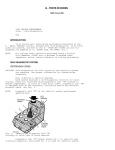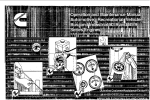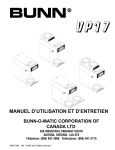Download Honda Code Breaker
Transcript
Honda Code part one Breaker part two Fuel Injected Hondas: Codes, Retrieval Methods, Real World Diagnoses n our last installment (February 1999 Import Service), we covered ECU locations and explained how to recover diagnostic trouble codes (DTC’s) from Honda engine management systems. This month we’ll discuss exactly what the codes mean, explain why and how a code can set and identify the high-percentage repair that will usually fix the car. Keep in mind I used the word usually. It’s difficult to make accurate generalizations, so it is impossible to name the actual cause of every possible DTC. In other words, there is no substitute for actual testing. Hondas are generally predictable, but I wouldn’t bet the farm on a hunch or on what happened yesterday. If you’ve tried my suggestions and still have a problem, get the meters out and run the voltage tests. You'll fix the car right, and you’ll learn something too. I PGM-FI light comes on, then run fine in open loop or limp-home mode. If that is the symptom, check to see that the sensors are plugged in correctly. Cylinders 1 and 4 are feedback-paired with the A oxygen sensor while cylinders 2 and 3 are feedbackpaired with the B sensor. Code 2 could be caused by a leaking injector, and if that injector were now switched to either number 1 or 4 cylinder, triggering Code 1, that could help verify the problem injector. Single Wire Oxygen Sensor Systems Codes: 1 And 2 Code 1 or 2 indicate an out-of-range signal has been received from the 02 sensor. Code 2 is used only on systems with two 02 sensors in the exhaust manifold. If both oxygen sensors were replaced and the lead wires were switched on the two sensors, the car may run poorly until the CHECK ENGINE or 24 Figure 1: Early models use a single wire zirconia oxygen sensor. Things got more complicated with later four and seven-wire sensors and multiple sensors. March 1999 Honda Code Breaker 02 sensor activity, or lack of it, is what sets the code. The parameters the ECU is looking for are: the 02 sensor voltage should be over 0.6 volts under WOT conditions and under 0.4 volts during closed throttle decel. At other throttle angles, a good 02 sensor may ‘crosscount’ as often as three times per second if viewed on a scope with the engine speed at approximately 3000 rpm. If the TPS is set correctly, your meter may show 0.0 volts briefly as the engine decels in ‘fuel-cut’ mode (closed throttle above 1200 rpm) after snapping the throttle open. There is approximately a 0.5 volt bias on the signal wire from the 02 sensor to the ECU. With the 02 sensor unplugged, the value on the harness side of the connector should read approximately 0.5 volts with the key on. If it reads 0.0 volts, unplug the ECU and check the wire for continuity to ground, if none is present, secure the connection at the ECU. If it reads high, check for a poor ground at the ECU. 1986-1987 CRX Si and Civic Si systems may set Code 1 from an unusually high quantity of fuel vapors purged from the charcoal canister during cruise conditions. While this might be construed as emissions tampering, a Honda motorcycle carburetor main jet (Honda P/N 2466555) inserted in the braided red purge hose at the top of the throttle body effectively meters the volume of canister purge to a manageable rate. At cruise conditions, the 02 voltage should be neither unusually high (which could indicate overfueling), or too low (which could be caused by clogged injectors or low fuel pressure). Backprobe the 02 sensor wire, using care not to also pierce the shield, then drive the car. You should see the 02 sensor voltage rise and fall under accel and decel conditions respectively, and crosscount at idle and cruise conditions. Oil or coolant contamination on the atmospheric port of the 02 sensor may kill the sensor. If a visual examination shows oil or any other contaminant at the oxygen sensor, repair the contaminant source, and replace the sensor. Coolant may wick down from the ground attachment point at the thermostat housing toward the 02 sensor. Repair the leak and replace the sensor. Four-Wire Oxygen Sensor Systems Codes: 1 P0131, P0132 41 P0135, P1166, P1167 43 Code 1 and 43 are basically the same as the oxygen sensor codes on the single wire systems. The four-wire sensors use an electric heater, however. There is a 12 volt key-on supply voltage to the 26 sensor, and the sensor ground is controlled by the ECU. The two wires on the sensor side of the connector correspond to heater power and ground. These wires are usually black. If a Code 41 appears (four long flashes and one short flash at the end), check the two black wires on the 02 sensor side of the connector for continuity. Typically you’ll find a 20-40 ohm reading on a good heater circuit. If the sensor circuit is open, replace the 02 sensor. Code 1 indicates an oxygen sensor problem, while the service manual calls Code 43 a ‘fuel system’ code. There’s no explanation why the ECU sets a Code 43 instead of a Code 1. For Code 43 the manual instructs you to look for things like leaking injectors, etc., which could also cause a Code 1. Don't worry about what number is displayed. The ECU just told you it doesn't like the 02 sensor, so we’ll leave it at that. The nice thing about heated 02 sensors is the car doesn't have to be running to see what's what. This heater can get the oxygen sensor warm enough to recreate a driven, warmed-up vehicle condition. Unplug the 02 sensor connector and check with the key on and a test light for the twelve volt power source, usually a B/Y or Y/B wire. Now with the sensor plugged in, ground the other wire in the connector that corresponds to the other black wire of the 02 sensor. This will turn the heating element on. The four-wire oxygen sensor still uses the same 0.5 volt bias voltage on the oxygen sensor signal wire. If we monitor that voltage with the key on and the heater activated, we should see 0.4-0.5 volts just as the key is turned on. That voltage should slowly fall to less than 0.1 volts within two minutes. If the engine is not running, there should be 21 percent 02 in the exhaust manifold, which would make an 02 sensor read very low. If the value stays at 0.5 volts and drops very slowly or not at all, replace the 02 sensor. Seven-Wire Oxygen Sensor Systems Code: 48 P1162, P1168, P1169 The seven-wire system is actually a linear air fuel ratio sensor, rather than an oxygen sensor in the traditional sense. Using this sensor as an input, the ECU can control the fuel mixture at 14.7 to 1 for most driving conditions, or at 22 to 1 for optimal fuel economy under ideal conditions. This sensor uses multiple heaters, and the book tests don't really give any insight as to what's occurring as far as tangible values. In most cases, replacement of the sensor is required if a problem is detected. Sensor replacement may become necessary with as little as 30,000 miles on the vehicle. March 1999 Honda Code Breaker The International Automotive Technicians’ Network is a group of 18,727 professional automotive technicians from all over the world. The automotive technician members of this group exchange technical knowledge and information with fellow iATN members. The combined knowledge of thousands of top industry professionals networking together helps the professional members of this group to provide the highest quality automotive repair, diagnosis and service in the world. If you are a professional automotive technician and would be interested in networking with other automotive professionals from all over the world, point your browser to h t t p : / / w w w. i a t n . n e t where you will find iATN Membership Information and Requirements. iATN Mission of Excellence “To promote the continued growth, success and image of the Professional Automotive Technician by providing a forum for the exchange of knowledge and the promotion of education, professionalism, and integrity.” 28 Figure 2: The plastic cover has been removed to get a glimpse of the MAP sensor and other EFI-related components mounted inside the control box on this early Accord PGM-FI model. Manifold Air Pressure Sensor Codes: 3 P0107, P0108 5 P0106 The MAP sensors are located in the black box on the firewall on early models and bolted directly on top of the intake manifold on some later models. The hose to the MAP sensor is always numbered 21 unless it's directly mounted to the top of the intake manifold. Code 3 indicates an electrical malfunction of the MAP sensor. There are three wires to Honda MAP sensors: a 5 volt reference, a ground and a signal wire. The signal wire should read about 2.9 volts with the key on and drop to about 0.8 volts at idle with 20-21 inches of manifold vacuum. If the output voltage reads as it should at the sensor, check the output wire right at the ECU. A signal of near zero volts or over 4.0 volts sets the code. Code 5 indicates a problem with the vacuum circuit. This means the ECU is receiving the correct voltage values, but they are not changing. If the MAP sensor hose is cut, this code will set because the output value did not change once the engine was started. Damaged MAP sensor hoses (where it attaches at the throttle body) are a common occurrence on 1988-91 Civics. A code could be set if the TPS shows a closed throttle voltage with an idle rpm value but the ECU sees 2.9 volts from the MAP sensor. The small orifice in the MAP sensor where the hose attaches may clog. If the MAP sensor bolts to the intake manifold, a carbon buildup may clog the opening. On models with the MAP sensor on the intake manifold, the TPS connector and MAP connector have the same configuration, and the harness connectors may be switched. While this may not set a code because the voltages will still be within normal operating parameters, it will sure cause a driveability problem. Look for this error if engine work has been done and you can't identify a driveability problem. March 1999 Figure 3: The bottom half of this distributor has been disassembled to reveal the CYL and TDC reluctors. A no-start condition may be caused by a rusted roll pin that secures the reluctors to the shaft. These parts are not available separately. Crank Angle Sensor (CRK) Codes: 4 P0335, P0336 8 P1359 Open, P1361, 1362 Top Dead Center Sensor (TDC) Code: 9 P1381, P1382 Cylinder Position Sensor (CYL) On 1985-89 Accords, 1985-87 Preludes and Civics through 1987, this sensor is built into the base of the distributor. The four-wire connector has very a distinctive terminal arrangement. Two vertical terminals serve one sensor, and the two remaining horizontal terminals in a straight line are connected to the other sensor. These are permanent-magnet signal generators. They have a resistance value of 300-1000 ohms (depending on the year and model), and produce at least 200 mv AC when the engine is running. If one sensor spec is 500 ohms, the other should be the same value. These early systems may exhibit a Figure 4: CYL and TDC wiring harno-start condition. ness connector. The two terminals The engine will have facing toward each other are conno injector pulse nected to the TDC sensor, the but will have spark. others to the CYL sensor. March 1999 Honda Code Breaker Coolant Sensor (TW) Code: 6 P0117 Low Input, P0118 High Input Figure 5: The permanent magnet CYL and TDC sensors inside the lower half of the distributor are electrically identical and should both produce the same resistance reading. This occurs when when the roll pin that secures the CYL/TDC reluctor to the distributor shaft rusts away. The reluctor may not spin with the distributor shaft; but the pickup coil for the igniter in the top of the distributor still functions, producing its signal. The sensors test fine with an ohmmeter, but produce no AC signal because there is no reluctor movement. Turn the key on, then hold a heavy duty trigger type soldering gun next to the base of the distributor. If the magnetic pulse of the soldering gun causes the injectors work but they do not work when you crank the engine, replace the distributor as a unit. Later models use two or three sensors integral with the distributor. Again, if one sensor reads 400 ohms, they should all read 400 ohms. In most cases the sensor (if separate, such as the CYL sensor on Preludes) or distributor needs replacing if these codes are set. Refer to the article on Honda ignition systems in the November 1998 Import Service for more information on this. Code 9 very often appears after replacing the timing belt on 1988-1989 Prelude models (and also the 198889 Acura Integra). There are two sensors in the distributor: CRK and TDC; and one CYL sensor driven by the exhaust camshaft. The ECU knows when these signals should occur in relation to each other. The CRK and TDC sensors are both in the distributor, so they are unlikely to get out of time. But if the cam belt is incorrectly installed or jumps a tooth, the ECU will recognize the CYL sensor is no longer in sync with the CRK and TDC sensors. If the code was not there before timing belt replacement, the likely cause is a cam belt that is off by one or more teeth between the intake and exhaust cams. Recheck the timing belt installation. If a car comes in with a broken timing belt, always remove the distributor to see whether it spins by hand. If the top bearing has frozen, it is very capable of snapping the cam belt. 30 The coolant sensor is under the distributor on most models. On 1985-89 Accords and 1985-87 Preludes, it's on top of the thermostat housing, and it's the sensor closest to the valve cover. It unfortunately has the same size and shape connector (read: “easily confused”) as the coolant fan timer temperature sensor right next to it. The sensors, however are not interchangeable. The TW sensor is a negative temperature coefficient sensor, while the fan timer sensor is an open/closed switch. Switching the sensor connectors will set Code 6. Coolant sensors are very hard to catch in the act of failing. Common complaints are a hard hot restart or the engine will not restart at all. The coolant sensor has a 5 volt reference from a R/W or Y/G signal wire depending on year and model, and a Br/B or G/W ground wire. When the engine is fully warmed up there should be about 0.5 volts on the signal wire and about 3.0-4.0 on a very cold engine. It should never read 0 or 5 volts when plugged in; these extremes will set a code. In the case of a hot restart complaint, warm the engine to operating temperature, monitoring the TW sensor voltage. Shut off the engine, then restart the engine while watching your voltmeter as you crank the engine after waiting five minutes. It should still be around 0.5-0.6 volts. If it shot up to 3.8 volts (or so) and the engine floods (long injector pulse), replace the coolant sensor. In most cases, Code 6 requires replacement of the TW sensor. Figure 6: The coolant (TW) sensor is right next to the cooling fan sensor on this early PGM-FI Accord. Their harness connectors are interchangeable, which can lead to problems. The green harness connector (closest to the valve cover) is attached to the coolant sensor. March 1999 Figure 7: The throttle position sensor is attached to one end of the throttle shaft. One of the headless anti-tamper screws is visible at the top of this sensor (arrow). Careful work with a sharp punch will usually loosen these screws if adjustment is necessary. Space is at a premium at the bottom of the sensor. Figure 8: The intake air temperature (TA) sensor is attached to the intake manifold (arrow). This one uses the same green harness connector also found on the coolant temperature (TW) sensor. Voltage readings from both sensors should match when the engine is cold. Throttle Position Sensor (TPS) Code: 7 (P0122 low input, P0123 high input) Intake Air Temperature (TA) Sensor Code: 10 P0112 Low Input P0113 High Input The throttle position sensor is in line with the throttle shaft on the throttle body. The TPS is a three-wire sensor with a 5 volt reference, a ground and a signal wire. Typically the signal is 0.48-0.50 volts with the throttle closed and goes to about 4.5 volts at wide open throttle. It should never read either 0.0 or 5.0 volts. The TPS is not replaceable without buying the complete throttle assembly. The heads of the screws holding the TPS in place shear off during installation. To attempt adjustment, a punch may be used to loosen the screws. Then replace them with standard Phillips or hex-head screws. Adjustment will never correct a code unless someone has already moved it way out of whack before you. When setting base idle on a 1988-91 Civic SPFI you will note that at 0.51 volts on the R/L signal wire, the top injector will start clicking. The top injector should not click at idle. If it does, monitor the TPS voltage when setting base idle. It should be around 0.48-0.50 volts at 600 rpm with the EACV unplugged. A reading of less than 0.51 volts is more important than an engine speed of exactly 600 rpm. If the TPS output voltage is too high, (over 0.6 volts at idle) it may prevent the Shift Interlock system from operating. The Shift Interlock system will not operate the lock solenoid on the shifter unless the brake pedal is depressed. It will also not operate the solenoid if it thinks you have the throttle open (pedal misapplication). If TPS voltage is over 0.6 volts, check for a carbon buildup on the throttle blade before attempting to adjust the TPS or condemning any parts. March 1999 The TA Sensor is usually located on the intake manifold and uses two wires just like the TW sensor — a signal wire (usually R/Y) which has a 5 volt reference and a ground. (G/W or Br/B) On early models a Code 10 was expressed as ten quick flashes, on later models it's one long flash. If you're not sure whether you’re seeing a Code 1 or a Code 10 (later models), unplug the 02 sensor with the key on to see how long a Code 1 takes. Was it the same quick flash, or a slower one? If the engine is cold, or has been sitting for a long while, the TW sensor and TA sensor should read the same voltage with the key on (plugged in). On 1990-1993 Accords, the TA sensor connector is very close to and interchangeable with the power steering pressure sensor. If a Code 10 appears, look for signs of body work, or an engine swap. The PS pressure switch, on the PS pressure hose, has solid color wires, red and black. Time Out A little knowledge can be dangerous. But too much knowledge can give you a headache! Honda diagnostic trouble codes are the key to a great deal of useful information, as the length of this multipart article indicates. I appreciate your patience for sticking with me so far. We’ve got one more installment to go before we’re finished with Honda’s diagnostic trouble code system. See you then. ■ —By Marlowe Peterson 31



























